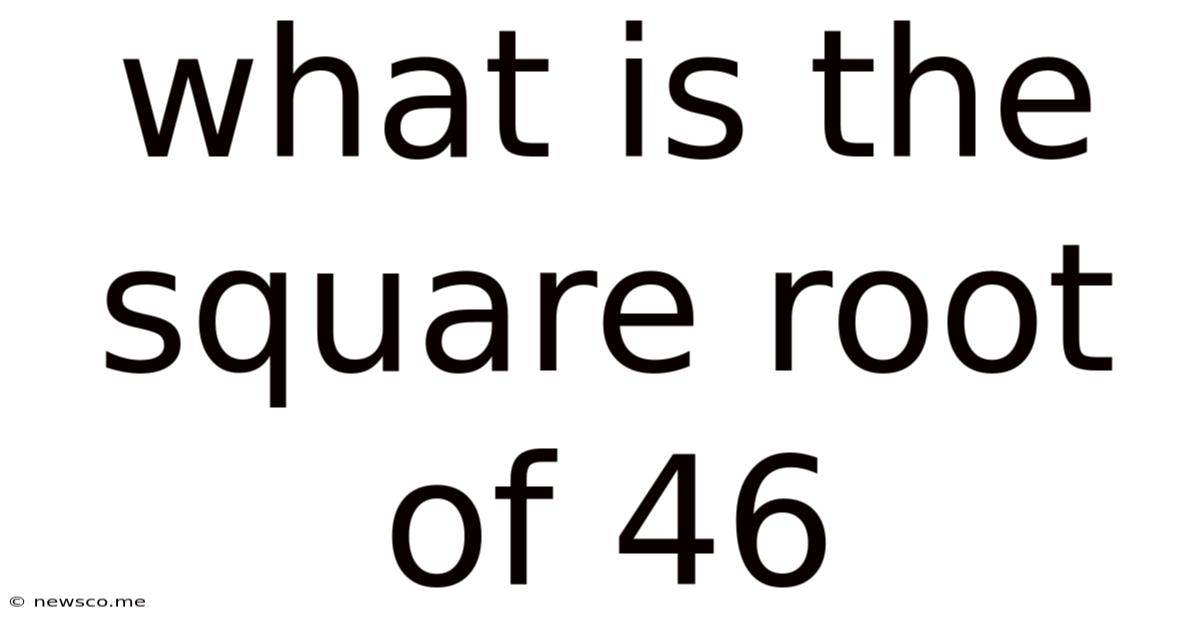What Is The Square Root Of 46
News Co
Apr 03, 2025 · 4 min read

Table of Contents
What is the Square Root of 46? A Deep Dive into Square Roots and Approximation Techniques
The question, "What is the square root of 46?" might seem simple at first glance. However, exploring this seemingly straightforward query opens doors to a fascinating world of mathematical concepts, approximation techniques, and the beauty of irrational numbers. This article will not only answer the question directly but will also delve into the underlying mathematical principles, exploring various methods to find the square root, and discuss the significance of irrational numbers in mathematics.
Understanding Square Roots
Before we tackle the square root of 46, let's solidify our understanding of what a square root actually is. The square root of a number is a value that, when multiplied by itself, equals the original number. For instance, the square root of 9 (√9) is 3 because 3 * 3 = 9. This is also known as the principal square root. It's important to remember that every positive number has two square roots: a positive and a negative one. However, unless otherwise specified, we generally focus on the principal, positive square root.
The Square Root of 46: An Irrational Number
Unlike the square root of 9, which is a whole number, the square root of 46 (√46) is not a perfect square. This means it cannot be expressed as a fraction of two integers. Numbers like √46 are called irrational numbers. They have decimal expansions that neither terminate nor repeat. This is a fundamental property, making their exact values impossible to fully represent.
Calculating the Approximate Value of √46
Since we can't express √46 exactly as a fraction or a terminating decimal, we rely on approximation methods. Several techniques exist, each with varying levels of accuracy and complexity:
1. Using a Calculator
The simplest method is using a calculator. Most calculators have a dedicated square root function (√). Simply input 46 and press the square root button. You'll get an approximation like 6.78232998313. This is accurate to several decimal places but is still an approximation.
2. The Babylonian Method (or Heron's Method)
This iterative method refines an initial guess to approach the square root. It's based on the principle that if 'x' is an overestimate of the square root of a number 'n', then n/x will be an underestimate, and the average of these two will be a better approximation.
Here's how it works for √46:
- Make an initial guess: Let's guess 7 (because 7² = 49, which is close to 46).
- Improve the guess: Divide 46 by the guess: 46 / 7 ≈ 6.57
- Average the guess and the result: (7 + 6.57) / 2 ≈ 6.785
- Repeat steps 2 and 3: Using 6.785 as the new guess, we repeat the process. Each iteration brings us closer to the actual value.
By repeating this process several times, you can achieve a high degree of accuracy. This method is particularly valuable for understanding the iterative nature of numerical approximation.
3. The Newton-Raphson Method
This is another iterative method, generally faster than the Babylonian method for achieving high accuracy. It involves using calculus to refine an initial guess. The formula for finding the square root of a number 'n' is:
x_(n+1) = 0.5 * (x_n + n/x_n)
Where:
- x_n is the current guess
- x_(n+1) is the next, improved guess
Similar to the Babylonian method, you start with an initial guess and repeatedly apply the formula until you reach the desired level of accuracy. This method requires a basic understanding of calculus.
4. Linear Approximation
This method uses the tangent line to the graph of f(x) = √x at a nearby perfect square to estimate the square root. Since 46 is close to 49 (7²), we can use this method:
- Find the tangent line: The derivative of √x is 1/(2√x). At x=49, the slope is 1/(2*7) = 1/14.
- Write the equation of the tangent line: y - 7 = (1/14)(x - 49)
- Substitute x = 46: y - 7 = (1/14)(46 - 49) = -3/14
- Solve for y: y = 7 - 3/14 ≈ 6.786
This provides a reasonably accurate approximation, though less precise than the iterative methods.
The Significance of Irrational Numbers
The fact that √46 is irrational highlights a crucial aspect of mathematics. Not all numbers can be expressed as simple fractions or terminating decimals. Irrational numbers, like π (pi) and e (Euler's number), play vital roles in various mathematical fields, including geometry, calculus, and number theory. Understanding their properties is fundamental to advanced mathematical concepts.
Conclusion: More Than Just a Number
The seemingly simple question of finding the square root of 46 opens a window into the rich world of mathematics. While we can easily obtain an approximate value using a calculator, exploring different approximation methods allows us to appreciate the elegance and power of mathematical techniques. Moreover, understanding the nature of irrational numbers provides a deeper understanding of the fundamental building blocks of mathematics and their importance in various scientific disciplines. This exploration extends far beyond a simple numerical answer, revealing the beauty and complexity hidden within seemingly simple mathematical problems. The journey of discovering the square root of 46 is a journey into the heart of mathematics itself.
Latest Posts
Related Post
Thank you for visiting our website which covers about What Is The Square Root Of 46 . We hope the information provided has been useful to you. Feel free to contact us if you have any questions or need further assistance. See you next time and don't miss to bookmark.